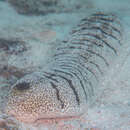mk
имиња во трошки


Holothuria fuscopunctata, the elephant trunkfish,[1] is a species of sea cucumber in the family Holothuriidae native to shallow water in the tropical Indo-Pacific. It is placed in the subgenus Microthele, making its full name Holothuria (Microthele) fuscopunctata.[2]
A large sea cucumber, H. fuscopunctata reaches a maximum length of 70 cm (28 in), although a more usual length is about half this. It can weigh up to 4.5 kg (10 lb).[3] The body wall is thick and golden-brown with darker spots and dark brown wrinkles. The underside is whitish, the mouth being surrounded by twenty thick brown tentacles and the anus surrounded by a black band. The cloaca is large and black, but there are no Cuvierian tubules.[3]
H. fuscopunctata has a wide distribution in the tropical Indo-Pacific. Its range extends from Madagascar and the eastern coast of Africa to Japan, China, Australia and the Mariana Islands, Palau and New Caledonia. Its depth range is down to a maximum of 30 m (100 ft); it is common in some parts of its range, but scarce in the Philippines, Federated States of Micronesia, and Marshall Islands. On the African coast it mostly occurs on sandy seabeds and seagrass meadows, but in the Central Pacific, it mostly occurs on reef slopes and on coral rubble, although it also lives in seagrass beds.[1]
This species feeds on organic material that it grazes on the seabed.[3] It is slow to mature and has low fecundity. The sexes are separate and breeding takes place in the warm season, between December and January.[3]
Sea cucumbers are eaten in the Central Pacific. H. fuscopunctata is not particularly esteemed, but it is eaten as a poverty food in times of hardship, such as after cyclones. It is mostly harvested by skin-diving, and is likely to face greater exploitation as other more favoured species become scarcer. There are fisheries in Malaysia, the Philippines, Vietnam and Indonesia; in Madagascar; in the Western Pacific, including the Torres Strait, and in Tuvalu. For the time being, the International Union for Conservation of Nature has assessed its conservation status as being of "least concern", but it is vulnerable to over-exploitation because of its low fertility rate.[1]
 In its natural environment
In its natural environment Holothuria fuscopunctata, the elephant trunkfish, is a species of sea cucumber in the family Holothuriidae native to shallow water in the tropical Indo-Pacific. It is placed in the subgenus Microthele, making its full name Holothuria (Microthele) fuscopunctata.
Holothurie trompe d'éléphant
L’holothurie trompe d'éléphant (Holothuria (Microthele) fuscopunctata) est une espèce de concombres de mer de la famille des Holothuriidae.
C'est une holothurie d'aspect caractéristique, avec un corps allongé en cylindre ovale (aplati sur la face ventrale), boudiné et arrondi aux deux extrémités. Cette holothurie peut mesurer jusqu'à 70 cm de long, mais dépasse rarement 50 cm en moyenne[2], pour un poids adulte oscillant entre 3 et 5,5 kg[2]. Sa couleur est assez variable : la moitié inférieure est souvent d'un blanc sale finement ponctué de noir, et la partie supérieure (appelée « bivium ») peut être du même ou colorée de fauve. Des lignes transversales noires sont souvent présentes sur le dos, au creux des rides. Le tégument est épais, et souvent couvert de sable fin. La bouche est ventrale et est entourée de 20 tentacules courts et bruns. À l'autre bout, l'anus est large et noir ; il n'a pas de dents anales mais est entouré de 5 papilles. Cette espèce n'a pas de tubes de Cuvier[2].
Cette espèce est souvent confondue avec Thelenota anax, d'écologie similaire mais pouvant atteindre des tailles encore plus imposantes. Cependant, cette dernière a moins souvent des rides transversales du niveau du dos, moins marquées, et porte en revanche presque toujours une ride longitudinale sur le côté. Sa silhouette est aussi plus angulaire, et elle est souvent couverte de verrucosités en relief parfois complexes. Son corps est aussi moins dur et de consistance plus spongieuse.
Cette espèce est très largement répartie dans le bassin Indo-Pacifique, de la côte est-africaine à la Polynésie. Espèce benthique, on la trouve posée sur le fond, sur des substrats sableux peu profonds (entre 3 et 25 m de profondeur)[2].
Comme toutes les holothuries de son ordre, cette espèce se nourrit en ingérant le substrat sableux, qu'elle trie grossièrement et porte à sa bouche à l'aide de ses tentacules buccaux pour en digérer les particules organiques[3].
La reproduction est sexuée, et la fécondation a lieu en pleine eau après émission synchronisée des gamètes mâles et femelles (les holothuries adoptent alors une position érigée caractéristique). La larve évolue parmi le plancton pendant quelques semaines avant de se fixer pour entamer sa métamorphose.
Cette espèce est comestible : elle est exploitée dans certains pays tropicaux pour l'export à destination de l'Asie du sud-est (principalement la Chine), où elle est consommée comme trepang de second choix en raison de sa saveur amère ; sa valeur commerciale est donc relativement faible[2].
Comme cette espèce est largement répandue, elle n'est pas considérée comme une espèce en danger par l'UICN[4].
Holothurie trompe d'éléphant
L’holothurie trompe d'éléphant (Holothuria (Microthele) fuscopunctata) est une espèce de concombres de mer de la famille des Holothuriidae.
Holothuria fuscopunctata is een zeekomkommer uit de familie Holothuriidae.
De wetenschappelijke naam van de soort werd in 1833 gepubliceerd door Wilhelm Friedrich Jaeger.
Bronnen, noten en/of referenties